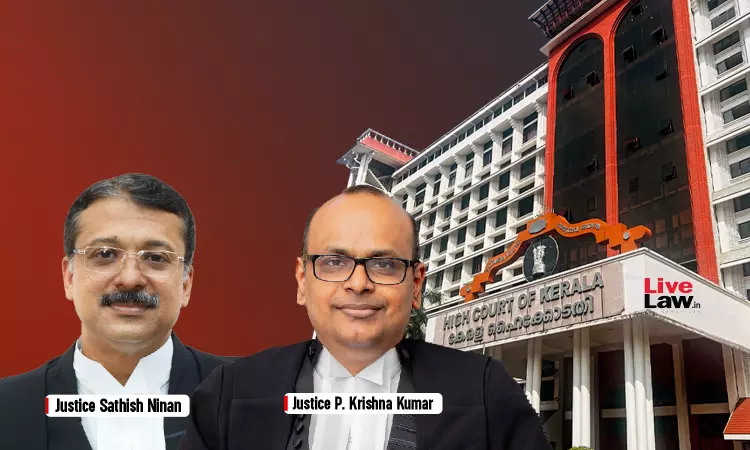- Home
- /
- High Courts
- /
- Kerala High Court
- /
- Customary Practice Of Divorce Can...
Customary Practice Of Divorce Can Be Proven In Evidence Even If Hearsay, Upon Satisfying Conditions U/S 32 Evidence Act: Kerala High Court
K. Salma Jennath
7 Oct 2025 11:51 AM IST
The Kerala High Court has recently held that a customary practice of divorce can be proven in evidence if the same is hearsay, if the statement satisfies the conditions under Sections 32(4) and 48 of the Indian Evidence Act.The Division Bench of Justice Sathish Ninan and P. Krishna Kumar was considering a matrimonial appeal challenging the decision of the Family Court declaring the respondents...
The Kerala High Court has recently held that a customary practice of divorce can be proven in evidence if the same is hearsay, if the statement satisfies the conditions under Sections 32(4) and 48 of the Indian Evidence Act.
The Division Bench of Justice Sathish Ninan and P. Krishna Kumar was considering a matrimonial appeal challenging the decision of the Family Court declaring the respondents as the wife and daughter of the appellant. It observed:
“The existence of a custom can also be proved in the manner provided in Section 48 of the Indian Evidence Act…the person through whom the existence of a custom is to be proved should be one who would be likely to know of its existence, if it existed. In the above context. Section 32 of the Indian Evidence Act is also of significance. Section 32(4) permits even written or verbal statements or opinions of a deceased person to be relevant when they relate to the existence of a custom, if made before the controversy arose and by a person who would naturally have been aware of such matters… To prove a custom it is not necessary that a person should have personally witnessed instances establishing the custom, since even hearsay evidence is admissible regarding the statement or opinion of a person about the existence of a custom, provided, the conditions of Section 32 of the Evidence Act are satisfied.”
According to the appellant, the first respondent was previously married to a person named Balan, and that marriage was not dissolved. He also denied his marriage with respondent 1 and having respondent 2. Respondent 1 contended that she divorced Balan as per the customary rites prevailing in the Hindu Thiyya community before marrying the appellant.
The Court noted that there was another round of proceedings when initially the respondents' suit for declaration was decreed in their favour, reversed in the first appeal and remanded by the High Court in the second appeal.
While remanding the case, two additional issues were formulated for adjudication: (1) Whether the said customary divorce is prevalent in the parties' community? (2) Whether the prior marriage of respondent 1 was dissolved by the customary divorce? Both these questions were answered in the affirmative in the judgment challenged.
The Court looked into Sections 4 and 29(2) of the Hindu Marriage Act (HMA) and found that the Act do not affect the rights of persons to obtain a customary divorce. It found that 'custom', as defined under Section 3(a) HMA, has the force of law if there is antiquity and continuity.
It further held that the existence of a custom can also be proved in accordance with Section 48 of the Evidence Act, and Section 32(4) is relevant in such a case.
The Court found that after the case was remanded, the respondent 1 pleaded in detail about the rituals performed for the customary marriage and customary divorce, but could not adduce evidence regarding the existence of the customary divorce in her community. Neither PW1 (respondent 1) nor PW9 could name any instance of or persons who have undergone customary divorce in the manner.
The Court observed:
“Their testimony falls short of the requirements of Sections 32(4) and 48 of the Evidence Act, since they cannot be said to be persons likely to know of the existence of such a custom, nor did they state anything reflecting the opinions or statements of persons falling within the scope of Section 32(4). In the absence of clear and reliable proof regarding antiquity, continuity, and reasonable certainty of the custom claimed, the alleged ceremony, if at all held, cannot be accepted as sufficient proof of custom within the meaning of Section 29(2) of the Act.”
It also noted that the recognition of customary marriage prevalent among Thiyyas of North Malabar in Achu v. Chandkurhan (1958 KLT 916) could not be used to prove the existence of a customary divorce among Thiyyas of respondent's community in Thalassery Taluk of Kannur.
Thus, the Court found that since the divorce from first marriage of respondent 1 could not be proved, her marriage with appellant would be void as per Section 11 r/w Section 5(i) HMA. But it also held the legitimacy of respondent 2 will not be affected in view of Section 16 HMA.
In the connected RP(FC) filed by the appellant challenging the maintenance awarded to the respondent 1, the Court found it fit to set aside the award since she was in another marriage and not the wife of the appellant. However, the Court made it clear that respondent 1 has the option of applying for permanent alimony before the Family Court. It also stated that the maintenance amount, if any, paid till now would be treated as pendente lite.
Thus, the Court allowed the appeal in part and set aside the declaration that the marriage of the appellant and the first respondent is valid. It allowed the RP(FC) and set aside the order of maintenance.
Case No: Mat. Appeal No. 630/2018 and R.P.(FC)No.126/2020
Case Title: Kizhakkayi Dasan v. Kuniyil Cheerootty and Anr.
Citation: 2025 LiveLaw (Ker) 627
Counsel for the appellant: K.P. Hareendran, Prajit Ratnakaran



